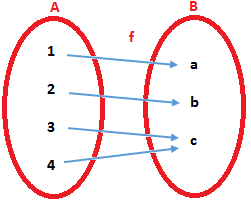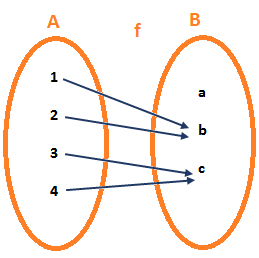Injection Function and Surjection Functions
Injection (or) One – One Function:
Definition: A function f: A → B is called an injection. if distinct element f – images in B. an injection is also called a one – one function.
f: A → B is an injection ⇔ a₁, a₂ ϵ A and a₁ ≠ a₂ implies that f(a₁) ≠ f(a₂)
f: A → B is an injection ⇔ a₁, a₂ ϵ A and f(a₁) = f(a₂) implies that a₁ = a₂
Examples: Let A = {a, b, c, d} and B = {1, 2, 3, 4, 5}
1. If f = {(a,3), (b, 5), (c, 1), (d, 4)} then f is a function from A into B and for different element in A, there are different f – images in B. hence f is an injection
2. If g = {(a, 2), (b, 2), (c, 3), (d, 5)}, then g is a function from A into B but g(a) = g(b). hence g is not an injection
3. Let f: R→R be defined by f(x) = 2x + 1. Then ‘f’ is an injection since for any a₁, a₂ ϵ R and f(a₁) = f(a₂) ⇒ 2a₁ + 1 = 2a₂ +1 ⇒ a₁ = a₂
Surjection (or) On – to Function:
Definition: A function f: A → B is called a Surjection. If the range f is equal to the co – domain of f.
function f: A → B is a surjection ⇔ range f = f(A) = B (co – domain)
⇔ B = {f(a) | a ϵ A}
⇔ for every b ϵ B there exists at least one a ϵ A such that f(a) = b
Hence, we may conclude that f: A → B is a surjection if every element of B occurs as the image of at least one element of A (i, e., every element in B has a ‘pre-image’ in A). a surjection is also called an onto function.
Example: Let A = {1, 2, 3, 4} and B = {a, b, c.}
1) If f = {(1, a), (2, b), (3, c), (4, c)} then f is a function from A to B and range f = f(A) = {a, b, c} = B the co – domain. Hence it is a surjection note that f is not an injection.

2) If g = {(1, b), (2, b), (3, c), (4, c)} then g is a function from A to B but not a surjection becomes there is no pre-image to the element a ϵ B. g is not an injection.

